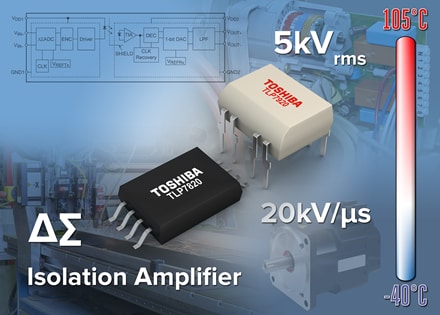- General Top
- SEMICONDUCTOR
- STORAGE
- COMPANY
-
My ToshibaSemicon
- Semiconductor Top
-
ApplicationsAutomotive
Body Electronics
xEV
In-Vehicle Infotainment
Advanced Driver-Assistance Systems (ADAS)
Chassis
IndustrialInfrastructure
BEMS/HEMS
Factory Automation
Commercial Equipment
Consumer/PersonalIoT Equipment
Healthcare
Wearable Device
Mobile
Computer Peripherals
-
ProductsAutomotive Devices
Discrete Semiconductor
Diodes
Transistors
Logic ICs
Analog Devices
Digital Devices
Wireless Devices
※
: Products list (parametric search)
Power SemiconductorsSiC Power Devices
※
: Products list (parametric search)
Isolators/Solid State RelaysPhotocouplers
Digital Isolators
Solid State Relays
Fiber Optic Transmitting Modules
※
: Products list (parametric search)
MOSFETsIGBTs/IEGTsBipolar Transistors※
: Products list (parametric search)
Diodes※
: Products list (parametric search)
MicrocontrollersMotor Driver ICsIntelligent Power ICs※
: Products list (parametric search)
Power Management ICsLinear ICs※
: Products list (parametric search)
General Purpose Logic ICsLinear Image SensorsOther Product ICsOther Product ICs
※
: Products list (parametric search)
-
Design & Development
Design & Development
Innovation Centre
At the Toshiba Innovation Centre we constantly strive to inspire you with our technologies and solutions. Discover how to place us at the heart of your innovations.
-
Knowledge
Knowledge
Highlighted Topics
Further Materials
Other
- Where To Buy
- Part Number & Keyword Search
- Cross Reference Search
- Parametric Search
- Stock Check & Purchase
This webpage doesn't work with Internet Explorer. Please use the latest version of Google Chrome, Microsoft Edge, Mozilla Firefox or Safari.
require 3 characters or more. Search for multiple part numbers fromhere.
The information presented in this cross reference is based on TOSHIBA's selection criteria and should be treated as a suggestion only. Please carefully review the latest versions of all relevant information on the TOSHIBA products, including without limitation data sheets and validate all operating parameters of the TOSHIBA products to ensure that the suggested TOSHIBA products are truly compatible with your design and application.Please note that this cross reference is based on TOSHIBA's estimate of compatibility with other manufacturers' products, based on other manufacturers' published data, at the time the data was collected.TOSHIBA is not responsible for any incorrect or incomplete information. Information is subject to change at any time without notice.
require 3 characters or more.
How to protect analogue circuits using isolation amplifiers
Much like the break pieces that are used to separate sections of a domino rally, optical isolation is used to separate different sections of an electrical circuit.
Why would you want to separate parts of a circuit? Well, the galvanic isolation provided by an optical isolator can protect sensitive components from potentially damaging high currents or voltages. Such isolation can also be useful for protecting sensors from interference or signal grounding problems.
Optical isolation is widely used for coupling circuits that are at different potentials, such as in the feedback circuitry of inverters in equipment like industrial motor drives and servos, photovoltaic systems, uninterruptible power supplies, and inverter-based motor controls in air conditioners and domestic appliances. It is also very useful for protecting operators from harmful voltages and currents.

At the heart of any photocoupler is an optical emitter, such as an LED and a photodetector, tuned to respond to the emitted wavelength. Photocouplers can transmit data incredibly quickly and are ideal for transmitting pulsed, or digital signals.
To provide isolation of an analogue signal, an ordinary optical isolator would require an analogue-to-digital converter (ADC) in front of the emitting LED. If an analogue signal was required on the other side of the isolation barrier, then a digital-to-analogue converter (DAC) would be required at the output of the receiver signal.
Isolation amplifiers integrate the necessary conversion circuitry to allow an analogue signal to be input to the emitter. Broadly speaking, two types of isolation amplifiers are available, that give designers the choice of an analogue output that is directly equivalent to the input signal, or an output that is a digital representation of the input signal.
To learn more about optical isolation and isolation amplifiers, simply click here:

